Looking at Martech guru Scott Brinker’s Marketing Technology Landscape Supergraphic below, you’ll quickly realize that marketers in 2019 have never before been wooed and courted with such an exhaustive suite of marketing solutions and technologies… 7040 and counting!
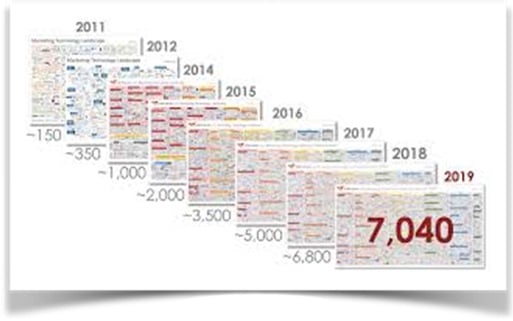
The Martech Landscape is spread out over 6 categories (Ads& Promotions, Content & Experience, Social & Relationships, Commerce & Sales, Data & Management) and 70 subcategories across platforms and processes designed to give you the unmatched power and capabilities of technology.
To save you precious time. To empower you with insights. To tell you what’s working or not working and why… all crucial in what is an increasingly complex marketplace with fickle customers whose last great experience is their benchmark for the next.
It’s no surprise then that this trend continues to ride an ambitiously upwards curve fueled by digital media proliferation, AI, machine learning and a host of other technological innovations.
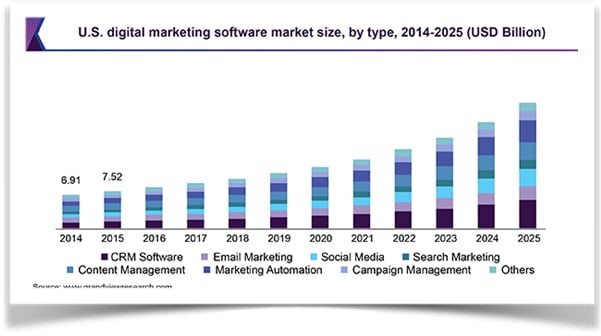
Seems like the Golden Age of Marketing, right? It definitely does on the surface as you skim through these amazing facts and figures.
But dig a little deeper and it’s closer to the adolescence of marketing as Tom Fishburne puts it!
Despite the promises of this veritable information “nirvana”, marketers everywhere continue to be frustrated, perplexed, and ultimately overwhelmed by this valuable but mismanaged bounty. They are either confused by the sheer volume of technologies in play or simply unable to reconcile the disparate data streams that are often hard to integrate.
As per a widely quoted study (Ref below) 59% users claim inability to fully utilize what they have while 91% claim that they do not have either the tools that they need or the ability to utilize them effectively.
Not so pretty anymore, right?
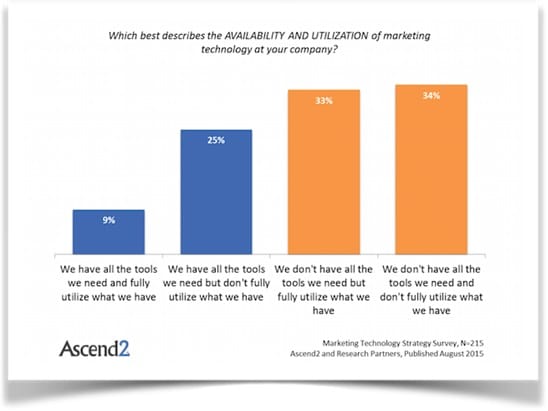
And even if one were to believe the 9% who claim to “have all the tools we need and fully utilize what we have”, our very understanding of the word “utilization” may be completely flawed. What is utilization ultimately and is it really the metric that we should be measuring to understand Martech Deployment?
Scott Brinker gives a rather interesting perspective in his article Martech stack utilization is a misguided metric.
He explains it rather brilliantly with a venn diagram as reproduced below.
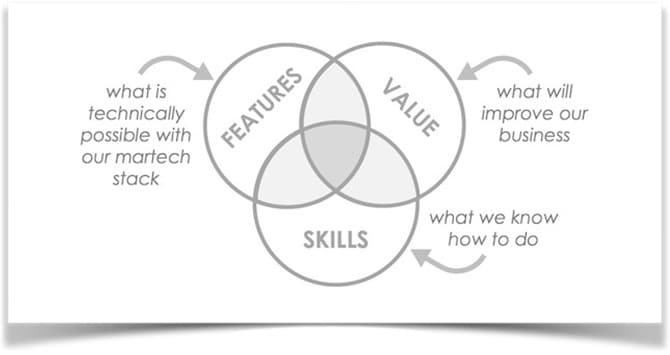
The 3 circles represent features (of the tool) available, skills (to deploy them) and value (business returns achieved).
He says that “ In a perfect world, these circles would overlap entirely. In practice, they don’t”.
So as he explains, the best case scenario for efficient utilization would be to invest in only those x features, for which we have ready capabilities as well as existing requirements in order to see commensurate value in real time. The Bigger the overlap, the bigger the value that we see from Martech.
Alas, that is almost never the case. For their own internal efficiencies vendors have to create mostly standardized, one-size-fits all tools which only offer upgrades as the customization options. Ever met a vendor who gave you a price off for NOT using 4 features? Not yet.
Therefore “utilization” is less a commentary on the effectiveness of MARTECH and more representative of market dynamics.
Therefore, instead of thinking in terms of the utilization of any given tool (in terms of features used vs features available) the more relevant metric to evaluate them would simply be the overall ROI achieved post installation.
As long as that is positive, it makes sense. If not, it is time to reconsider.
Scott Brinker goes on to posit the Martec’s law where he shows that organizational change lags behind technological changes thereby creating an expectation or inefficiency gap.
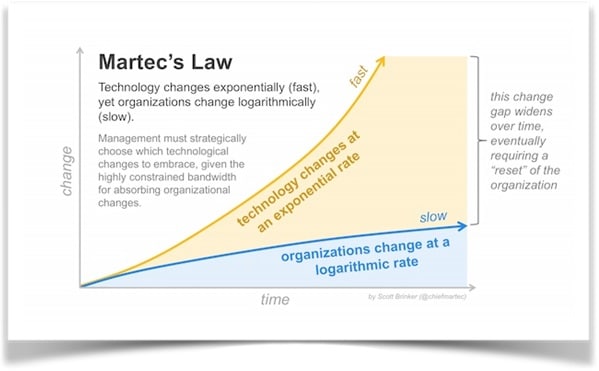
And It appears that our ability to mine data has grown exponentially faster than our ability to leverage that data for actionable insights.
A fascinating concept, it suggests a more realistic adoption of technology regardless of the technological gastronomy on offer. We need to consume a diet that we can digest and use effectively - be it food or technology.
So as counter intuitive as it may seem at first glance, more tools and more data has not necessarily made us better marketers... at least not as a general rule.
One could argue however that we are stumped by the complexity of our own technology simply because we don’t spend enough time understanding or optimizing our existing marketing stack. Pressured with deadlines, short on resources, we chase every new shiny object in the hope that it will do what the previous x shiny objects were unable to do... Do our marketing for us!

So in theory, if we were to take the time to understand our own business requirements as well as take the time to evaluate existing systems, we may be able to better integrate and leverage newer technology faster. Sounds reasonable, doesn’t it?
But for the sake of argument let’s also take a look at the Gartner’s Digital Marketing Transition Map as below that maps operational areas, applications, technologies, and vendors — and how they relate.
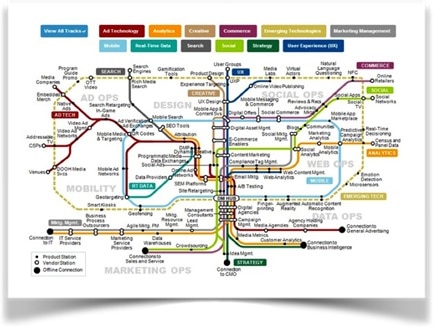
Designed to help navigate the rather complicated marketing ecosystem, this map provides a bird’s eye view of a marketer’s task in 2019
And to quote Scott Brinker again (hey.. I can’t help it... I know what I know because I do such a good job of reading everything he writes!)
“Looking at this map, you cannot help but be awestruck by the breadth and depth of digital marketing. I mean, holy cats, I work in this space for a living and write this blog as my hobby — I know, I don’t get out much — and I don’t even know some of these stations. Many of them I have only a passing familiarity with”.
Now imagine being a marketer tasked with first prioritizing and then optimizing these many tracks, channels, and sub strategies to build a cohesive strategy and campaign aligned to one’s business goals.
There is simply no technology that I know of that can seamlessly integrate and feed off the individual data requirements and spit them out in a clean dashboard. It requires extraction of insights from multiple tools only to be held hostage by contradictory outcomes.
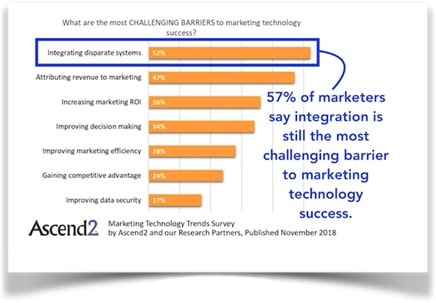
And the pain doesn’t stop there. If you didn’t notice the 7040 vendors on the first page, let me bring them up again. Every day of his life, a marketer remains answerable for the new technology or tool they chose NOT to deploy in favor of the one they did.
Is it any wonder then that the biggest challenges for vendors are surmounting team resistance & apprehensions rather than outperforming competitive pitches?
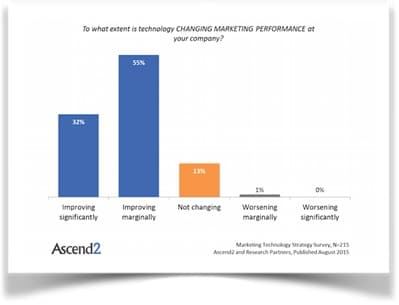
The spending breakdown below gives us some further idea of why this might be. Garner’s CMO Spend Survey 2017-2018 reveals a 9% YOY increase in Martech mostly at the expense of sidelining human talent or labor, which fell from 27 to 24 per cent.
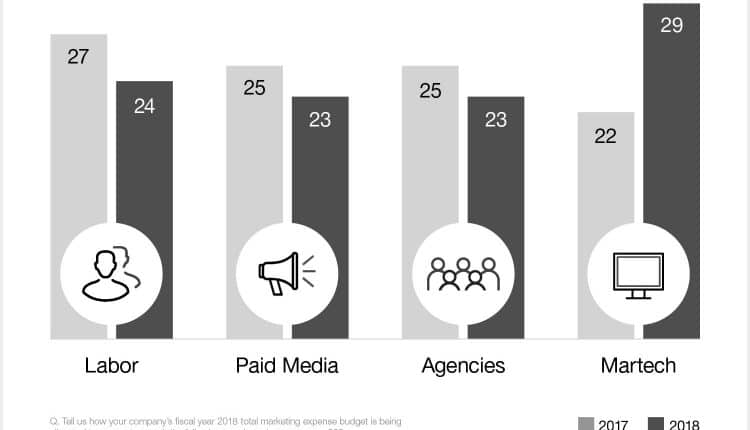
When all is said and done, it’s important to understand that digital marketing and transformation have together created a very confusing and fragmented landscape of technologies and providers. Piecemeal purchases have further compounded the problem by creating silos that do not relate to each other or at the very least need a lot of additional technological and manual support to do so.
The struggle is real.
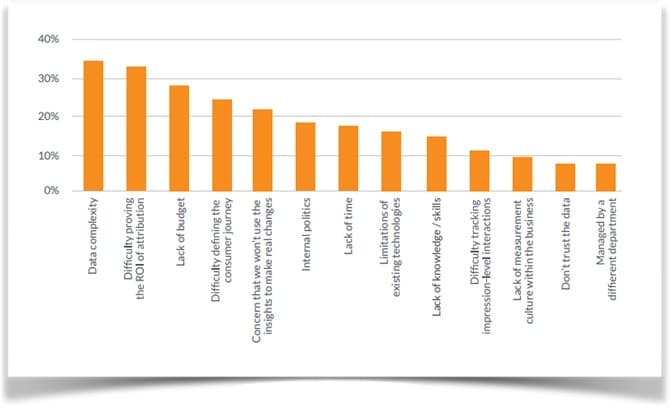
As per the above study from Clickz, data complexity is one of the foremost challengers for marketers. While solutions include acquiring the tools and talent necessary for better analysis, there is still a big shortage of trained data analytic professionals.
But Hey - Don’t throw the baby out with the bathwater
When all is said and done, it’s important to understand that however daunting, technology is simply an enabler and a logical response to the need for faster automation in an increasingly agile marketplace. Without it, you simply cannot compete. With it, you’re still in the game.
We desperately need to find a way to optimize our Martech and data quality so that it provides us with the agility and momentum that we so desperately need.
One place to start is to accept poor choices made in the past, before unraveling decades of legacy software, outdated skill sets and mismatched expectations. This exercise will be the logical starting point of understanding what the business of today really needs, what you have (and can leverage) and finally, what you need.
Final words..… on the feeling of missing out
The cost of onboarding a new tool is not just the upfront set up, training and product cost but also the opportunity cost of NOT having bought something else… something better that your competitors may be deploying right about now as you ruminate on the MARTECH landscape.
Looking back at the 7040 tool infographic, once the initial feeling of surprise settles down, what we have is a feeling of worry... of having missed out on a better solution or hack.
And that my friends is the crux of the MARTECH problem.